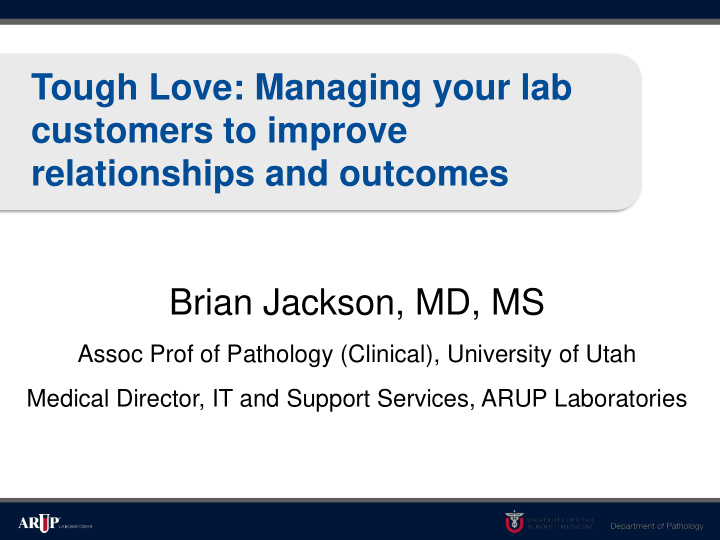



Tough Love: Managing your lab customers to improve relationships and outcomes Brian Jackson, MD, MS Assoc Prof of Pathology (Clinical), University of Utah Medical Director, IT and Support Services, ARUP Laboratories
Myth: Exceptional service requires complete deference to customer requests
Where high customer deference makes sense:
And where it doesn’t:
Facts: • Customers’ requests often don’t represent the best ways to meet their needs • Customer requests can have unintended consequences – High deference to customers requires high flexibility – High flexibility entails major tradeoffs in both cost and quality. • Most customers care more about cost and quality than about getting things “their way”
Common Customer Problems in Laboratories • Inappropriate test orders • Requests for customization to fit customer convenience • Specimen collection and submission errors • Missing or erroneous information on orders
Goal of this presentation Describe ways in which clinical laboratories can: • Create better partnerships with customers • Make it easier for customers to follow desired behaviors
But won’t customers be offended if you tell them what to do?
Achieving High Quality in a Service Business The customer is an active participant; not simply a passive user. Therefore: Service quality is dependent on the customer’s behavior.
Applied Behavioral Economics • Human thinking isn’t perfect • Use the imperfection to your advantage
Fast vs Slow Thinking • Humans spend most of our time in System 1 (fast) thinking mode – Intuitive – Quick – Honed by experience – But subject to biases • Humans only switch to System 2 (deep thinking) when there’s a reason to do so • Source: Thinking, Fast and Slow. 2013 : Daniel Kahneman
Shortcuts
Mental Shortcuts • Default Effect • Bandwagon effect • Stereotyping • Reciprocity • Attribution bias • Availability heuristic • Loss aversion • And on and on…
Default Effect: When given a choice between several options, the tendency to favor the default one.
Default Effect: Retirement Plans • Workers are 15 times more likely to save for retirement when their employers offer retirement plans • For workplaces offering retirement plans: – If workers have to sign up, 70% will participate – If they’re signed up automatically, 90% will participate • Source: AARP
Default Effect: Opiate Prescriptions • Two emergency departments lowered the default number of pills for opiate prescriptions in their EHR • Prescriptions for 10 pills (the new default) increased by 22% • Source: Delgado MK et al. JGIM 2018. 33(4):409-411.
Default Effect: Laboratory Ordering • Standardized order sets • Limited panels • Reflex panels • Removal of tests from menu
Default Effect: Specimen Handling • Standardized collection kits • Visual clues • Standardized handoff and submission processes
Bandwagon Effect: The tendency to do or believe things because many other people do/believe the same.
Bandwagon Effect (Herd Mentality): English Tax Collections • Simple reminders: “We have not received your return; please file it…” – 33% response • “Social” reminders: “Nine out of ten people with a debt like yours, in your area, pay their tax on time. You are in the minority…” – 39% response Source: www.behaviouralinsights.co.uk
Bandwagon Effect: Blood Product Utilization • Cardiac surgery transfusion protocol: reduce target Hbgb to 8 g/dL • Both group and individual feedback on protocol adherence – 50% reduction in transfusions in patients with Hgb > 8 g/dL • Source: Beaty CA et al. Ann Thorac Surg 2013; 96(6):2168-2174
Bandwagon Effect: Zipcar
Cultural reinforcement • Culture = common ground, unwritten expectations • What cultural values do we share in clinical medicine? – Patient comes first – High performance – Evidence-based medicine
Summary • High service quality requires active management of customers • Customers value quality more than they value deference • Nudging is a powerful way to manage customers – Default options – Bandwagon effect
Recommend
More recommend